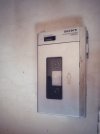johnwick94
Member
My instagram page.
Sony TCM-600 (1978)
"Pressman" Sony's Walkman history starts with this device. Dictaphone with mono output.
In the autobiography of Akio Morita Co-founder of Sony - "Made in Japan" he stated "The idea took shape when Ibuka came into my office one day with one of our portable stereo tape recorders and a pair of our standard-size headphones. He looked unhappy and complained about the weight of the system. I asked him what was on his mind and then he explained, "I like to listen to music, but I don't want to disturb others. I can't sit there by my stereo all day. This is my solution-I take the music with me. But it's too heavy."
I had been mulling an idea over in my mind for a while, and now it was coming into focus as Ibuka talked. I knew from my own experience at home that young people cannot seem to live without music. Almost everybody has stereo at home and in the car. In New York, even in Tokyo, I had seen people with big tape players and radios perched on their shoulders blaring out music. I remembered that one time when my daughter, Naoko, came home from a trip she ran upstairs before even greeting her mother and first put a cassette in her stereo. Ibuka's complaint set me into motion. I ordered our engineers to take one of our reliable small cassette tape recorders we called "Pressman" strip out the recording circuit and the speaker, and replace them with a stereo amplifier. I outlined the other details I wanted, which included very lightweight headphones that turned out to be one of the most difficult parts of the Walkman project."
Finally they developed Sony Walkman TPS-L2 & Sony MDR-3L2

Sony TCM-600 (1978)
"Pressman" Sony's Walkman history starts with this device. Dictaphone with mono output.
In the autobiography of Akio Morita Co-founder of Sony - "Made in Japan" he stated "The idea took shape when Ibuka came into my office one day with one of our portable stereo tape recorders and a pair of our standard-size headphones. He looked unhappy and complained about the weight of the system. I asked him what was on his mind and then he explained, "I like to listen to music, but I don't want to disturb others. I can't sit there by my stereo all day. This is my solution-I take the music with me. But it's too heavy."
I had been mulling an idea over in my mind for a while, and now it was coming into focus as Ibuka talked. I knew from my own experience at home that young people cannot seem to live without music. Almost everybody has stereo at home and in the car. In New York, even in Tokyo, I had seen people with big tape players and radios perched on their shoulders blaring out music. I remembered that one time when my daughter, Naoko, came home from a trip she ran upstairs before even greeting her mother and first put a cassette in her stereo. Ibuka's complaint set me into motion. I ordered our engineers to take one of our reliable small cassette tape recorders we called "Pressman" strip out the recording circuit and the speaker, and replace them with a stereo amplifier. I outlined the other details I wanted, which included very lightweight headphones that turned out to be one of the most difficult parts of the Walkman project."
Finally they developed Sony Walkman TPS-L2 & Sony MDR-3L2


